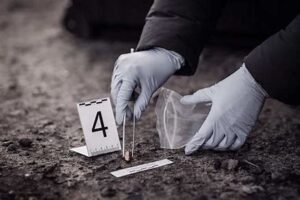Abstract:
Criminal investigation is a complex and multifaceted process that plays a crucial role in the pursuit of justice and the maintenance of law and order. This essay provides a comprehensive analysis of criminal investigation, exploring its techniques, challenges, and ethical considerations. Drawing on insights from criminology, forensic science, and law enforcement, the essay examines the various stages of the investigative process, from crime scene analysis and evidence collection to suspect identification and case resolution. Furthermore, the essay discusses the challenges faced by investigators, including resource constraints, technological advancements, and ethical dilemmas. By shedding light on the intricacies of criminal investigation, this essay aims to deepen understanding and inform efforts to enhance investigative practices and uphold the principles of justice.

I. Introduction:
Criminal investigation is the process of gathering, analyzing, and interpreting evidence to uncover the truth behind criminal acts and hold perpetrators accountable for their actions. It is a critical component of the criminal justice system, serving as the foundation for the prosecution of crimes and the administration of justice. Criminal investigators play a crucial role in ensuring that the guilty are brought to justice while safeguarding the rights of the innocent. This essay provides an in-depth analysis of criminal investigation, examining its techniques, challenges, and ethical considerations, and exploring its role in the pursuit of justice.
II. The Investigative Process:
The investigative process involves a series of systematic steps aimed at uncovering the truth behind criminal acts and identifying those responsible for committing them. These steps typically include:
A. Crime Scene Analysis: The first step in the investigative process is to analyze the crime scene to identify potential evidence, establish the sequence of events, and identify possible suspects. Crime scene analysis involves careful observation, documentation, and preservation of physical evidence, such as fingerprints, DNA samples, and trace materials.
B. Evidence Collection and Preservation: Once potential evidence has been identified, investigators must collect and preserve it in a manner that maintains its integrity and admissibility in court. This may involve the use of specialized tools and techniques, such as forensic evidence kits, chain of custody procedures, and crime scene reconstruction.

C. Suspect Identification and Interrogation: Investigators use various methods to identify and apprehend suspects, including witness interviews, surveillance footage analysis, and forensic databases. Once a suspect has been identified, investigators may conduct interviews, interrogations, and surveillance to gather additional evidence and elicit incriminating statements.
D. Case Resolution and Prosecution: The final stage of the investigative process involves the compilation of evidence, the preparation of case files, and the presentation of findings to prosecutors for review and potential prosecution. Investigators work closely with prosecutors to build strong cases, secure convictions, and ensure that justice is served.
III. Forensic Techniques in Criminal Investigation:
Forensic techniques play a crucial role in criminal investigation, providing investigators with the tools and methods needed to analyze physical evidence and link suspects to crime scenes. Some of the most commonly used forensic techniques include:
A. DNA Analysis: DNA analysis is a powerful tool for identifying suspects, linking individuals to crime scenes, and exonerating the innocent. DNA evidence can be collected from various sources, such as blood, saliva, hair, and skin cells, and analyzed using techniques such as polymerase chain reaction (PCR) and short tandem repeat (STR) analysis.
B. Fingerprint Examination: Fingerprint examination is a fundamental forensic technique used to identify individuals based on unique patterns of ridges and furrows on their fingertips. Fingerprint evidence can be collected from various surfaces using specialized powders, chemicals, or adhesive tapes and compared to known prints in databases to identify suspects.

C. Ballistics Analysis: Ballistics analysis involves the examination of firearms, ammunition, and ballistic evidence to link weapons to crimes and identify suspects. Ballistics experts use techniques such as bullet trajectory analysis, firearm comparison, and gunshot residue analysis to determine the type of weapon used, the direction of fire, and other relevant information.
D. Digital Forensics: Digital forensics involves the examination of electronic devices, such as computers, smartphones, and hard drives, to recover and analyze digital evidence related to criminal activities. Digital forensic techniques include data recovery, file carving, and network analysis, allowing investigators to uncover deleted files, trace online communications, and reconstruct digital timelines.
IV. Challenges in Criminal Investigation:
Criminal investigation is fraught with challenges, including resource constraints, technological advancements, legal and procedural challenges, and ethical dilemmas. These challenges can impact the effectiveness, efficiency, and integrity of investigative practices, posing obstacles to the pursuit of justice and the protection of human rights. Some of the key challenges in criminal investigation include:

A. Resource Constraints: Law enforcement agencies often face limited resources, including funding, personnel, and equipment, which can hinder their ability to conduct thorough and comprehensive investigations. Resource constraints may result in backlogs, delays, and inefficiencies in the investigative process, undermining the timely resolution of cases and the delivery of justice.
B. Technological Advancements: Rapid technological advancements present both opportunities and challenges for criminal investigation. While new technologies such as DNA analysis, digital forensics, and surveillance technologies have revolutionized investigative practices, they also raise concerns about privacy, data security, and the misuse of technology for surveillance and control.
C. Legal and Procedural Challenges: Criminal investigation is subject to legal and procedural constraints, including rules of evidence, chain of custody requirements, and constitutional safeguards. Investigators must navigate complex legal frameworks, adhere to strict procedural guidelines, and respect the rights of suspects and victims, ensuring that evidence is obtained lawfully and ethically.
D. Ethical Dilemmas: Criminal investigation raises ethical dilemmas related to privacy, confidentiality, and the rights of suspects and victims. Investigators must balance the pursuit of justice with respect for human rights, ensuring that investigative techniques are conducted ethically and transparently. Moreover, investigators may face pressures to cut corners, bend rules, or compromise ethical standards in pursuit of convictions, risking miscarriages of justice and undermining public trust in law enforcement.
V. Ethical Considerations in Criminal Investigation:
Ethical considerations play a crucial role in criminal investigation, ensuring that investigative practices are conducted with integrity, transparency, and respect for human rights. Investigators must adhere to ethical standards and professional norms, upholding principles of fairness, impartiality, and due process throughout the investigative process. Some of the key ethical considerations in criminal investigation include:
A. Respect for Human Rights: Investigators must respect the rights and dignity of suspects, victims, and witnesses, ensuring that investigative practices are conducted in a manner that upholds their fundamental rights to privacy, due process, and fair treatment under the law.
B. Integrity and Transparency: Investigators must maintain the integrity and transparency of the investigative process, avoiding conflicts of interest, bias, or undue influence that may compromise the objectivity and impartiality of their findings. They should adhere to strict ethical guidelines, disclose any potential conflicts of interest, and ensure that investigative practices are conducted with honesty and integrity.
C. Avoidance of Bias and Prejudice: Investigators must guard against bias, prejudice, and stereotyping in their approach to criminal investigation, ensuring that decisions are based on objective evidence and sound reasoning rather than subjective judgments or preconceived notions. They should remain open-minded, impartial, and fair-minded in their interactions with suspects, victims, and witnesses, avoiding assumptions or stereotypes based on race, ethnicity, gender, or other personal characteristics.
D. Protection of Confidentiality: Investigators must protect the confidentiality and privacy of sensitive information obtained during the investigative process, ensuring that privileged communications, personal data, and sensitive materials are handled with care and discretion. They should comply with legal and ethical obligations regarding confidentiality, disclosure, and data protection, safeguarding the rights and interests of individuals involved in criminal investigations.

VI. Case Studies: Notable Criminal Investigations:
Several notable criminal investigations have highlighted the challenges and complexities of the investigative process, illustrating the importance of thoroughness, professionalism, and adherence to ethical standards. Some of the most high-profile criminal investigations include:
A. The O.J. Simpson Murder Case: The investigation into the murders of Nicole Brown Simpson and Ronald Goldman in 1994 captivated the nation and raised questions about race, celebrity, and the criminal justice system. The case involved extensive forensic evidence, including DNA analysis, blood spatter analysis, and shoeprint comparisons, as well as controversial investigative techniques such as the handling of evidence and the conduct of key witnesses.
B. The Unabomber Investigation: The investigation into the Unabomber, Theodore Kaczynski, who carried out a series of bombings over two decades, presented unique challenges for law enforcement agencies. The case involved the use of forensic linguistics, behavioral analysis, and other specialized techniques to identify and apprehend the suspect, highlighting the importance of interdisciplinary collaboration and innovative investigative approaches.
C. The Madoff Ponzi Scheme: The investigation into the Ponzi scheme orchestrated by Bernard Madoff exposed widespread fraud, corruption, and regulatory failures in the financial industry. The case involved complex financial transactions, forensic accounting, and regulatory oversight, as well as challenges related to jurisdictional issues, international cooperation, and the protection of investor rights.
VII. Future Directions in Criminal Investigation:
The future of criminal investigation is shaped by ongoing technological advancements, evolving legal frameworks, and emerging ethical considerations. Future directions in criminal investigation include:
A. Technological Innovations: Advancements in forensic science, digital forensics, and surveillance technologies will continue to enhance the capabilities of criminal investigators, enabling them to analyze complex evidence, trace digital footprints, and identify suspects with greater accuracy and efficiency.
B. Legal Reforms: Reforms in criminal procedure, evidence law, and privacy regulations will shape the legal framework for criminal investigation, ensuring that investigative practices are conducted in accordance with constitutional principles, human rights standards, and ethical guidelines.
C. Ethical Guidelines: The development of ethical guidelines and professional standards for criminal investigation will promote integrity, transparency, and accountability in investigative practices, ensuring that investigators adhere to ethical principles and respect the rights of individuals involved in criminal investigations.
D. Interdisciplinary Collaboration: Collaboration between law enforcement agencies, forensic scientists, legal experts, and other stakeholders will facilitate interdisciplinary approaches to criminal investigation, fostering innovation, knowledge-sharing, and best practices in investigative techniques and methodologies.
Conclusion:
Criminal investigation is a dynamic and challenging field that requires a combination of scientific expertise, investigative skills, and ethical integrity. Investigators play a crucial role in uncovering the truth behind criminal acts, securing evidence, and holding perpetrators accountable for their actions. By adhering to ethical standards, professional norms, and legal principles, investigators can ensure that the investigative process is conducted with integrity, transparency, and respect for human rights. Moreover, by embracing technological innovations, legal reforms, and interdisciplinary collaboration, investigators can enhance their capabilities and effectiveness in combating crime and upholding the principles of justice.




tempore impedit eius voluptatem veniam et. alias esse rerum ea quos consequuntur dolorem ut libero provident. dolores consequatur amet earum facilis aut sit sapiente nobis quod minus impedit fuga.